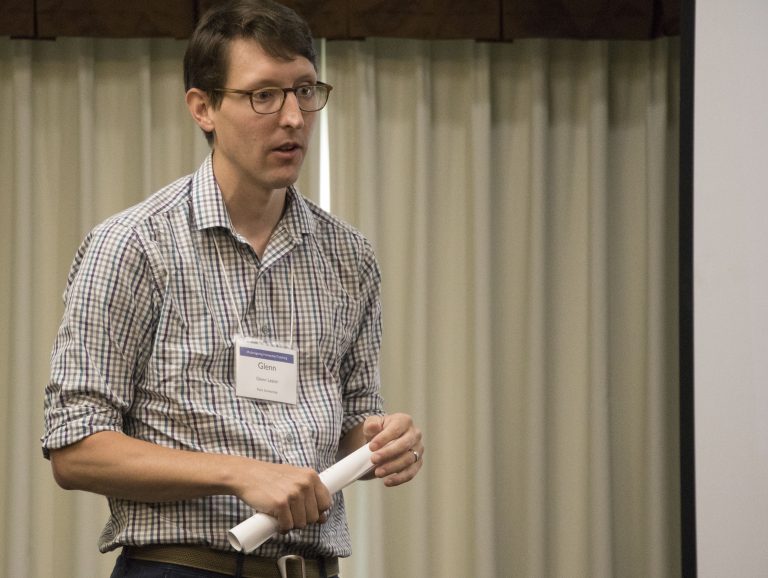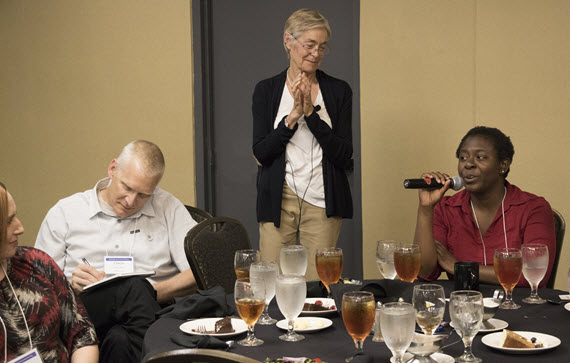KANSAS CITY, Mo. – The humanities have gone through much soul-searching over the past few years. So asking instructors in the humanities to take on hard questions about the way they teach seems like a natural step.
For instance, what do they value in their teaching? Is that truly reflected in their teaching and assignments? Why do they teach the humanities? What is humanities teaching and learning good for?
Those are some of the questions that arose in opening sessions this week at the (Re)imagining Humanities Teaching conference in Kansas City. The conference is the final event of the Collaborative Humanities Redesign Project, a three-year program involving faculty at KU, Park, Rockhurst and Elon universities. Dan Bernstein, the former director of the Center for Teaching Excellence at KU, has led the project, which was financed by a grant from the Teagle Foundation.

In one of the opening workshops, Glenn Lester, an assistant professor of English at Park University, asked participants to explore what they, as instructors, valued in writing. That’s important, he said, because instructors usually focus on the skills they want students to acquire but rarely engage in a deep reading of the feedback they give to students.
Lester did just that with a semester’s worth of papers, categorizing his feedback and creating a rubric that articulated what he was really looking for in student writing. He found that students’ writing seemed too generic and that he needed to adjust his teaching of the class. He used the evaluation of comments as a guide.
He found two important things, he said. First, he hadn’t been emphasizing the need for students to explain the relevance of their work, the “so what?” question. He also realized he valued the curiosity that students displayed in their writing, and wanted them to reveal more of their metacognitive processes.
He used the rubric he created from those comments not for students but for himself. It became a tool to self-assess the elements of writing he needed to make more explicit to students in his teaching. In a portfolio he created about the changes he made in the class, he offered this:
“But most of all, I want my students to care. I want them to care about what they write about. I want them to recognize that their words, their ideas and their experiences have value. I want them to use writing and research as tools to explore their own interests, curiosities, and communities.“
In the opening plenary, Peter Felten, assistant vice provost for teaching and learning at Elon University, asked conference participants to reflect on the purposes of humanities teaching. They offered many ideas:
- making connections
- explaining what it means to be human
- learning about subjectivity
- understanding the self through the other
- cultivating empathy
- appreciating ambiguity
- exploring the world through multiple perspectives, memories and histories
- learning the importance of text and context, as well as narrative, perspective and representation
Felton then asked participants whether those larger goals were the ones they talked about on their last day of classes. That is, do they follow through on those aspirational goals. If not, why?

He then offered a synthesis of the goals that participants in the Collaborative Humanities Redesign Project had expressed in portfolios they created on their course redesign work. The recurring themes, he said, were to set meaningful goals; practice, practice, practice; and then give feedback on student work.
Digging a bit deeper, he offered a reading of how CHRP participants approach reflective teaching, saying that three themes emerged:
- Treat student work as the core text.
- Expect messiness and failures.
- Learn with colleagues.
He offered a final thought for conference participants to consider: What if we looked into not just student skills, but their habits of mind. What would we see in our students’ work?
It was a rhetorical question, but one that spoke to the goals and aspirations of the many excellent teachers in the crowd, and to the continued soul-searching that instructors in the humanities must keep doing.
Doug Ward is the associate director of the Center for Teaching Excellence and an associate professor of journalism. You can follow him on Twitter @kuediting.